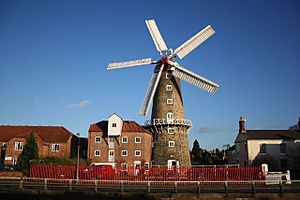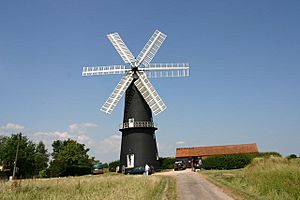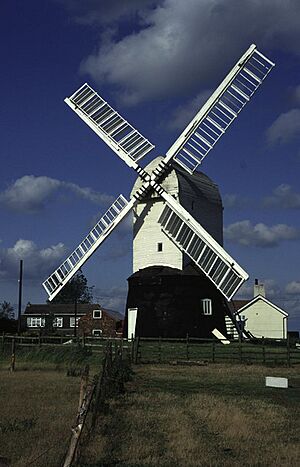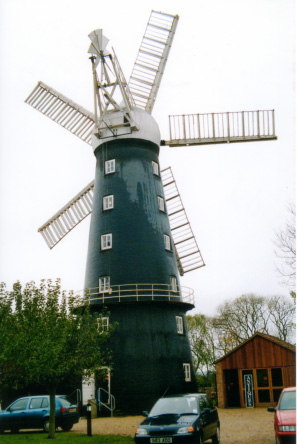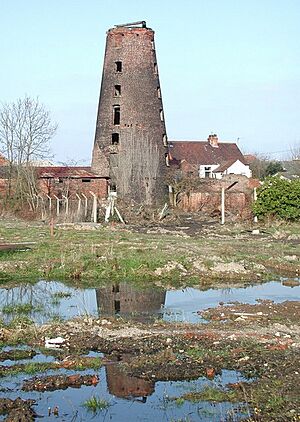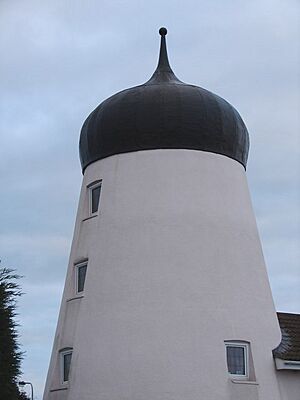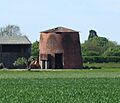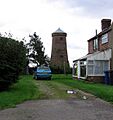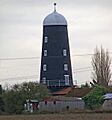List of windmills in Lincolnshire facts for kids
Lincolnshire is a county in England that was once home to many windmills. These tall structures used the power of the wind to grind grain into flour or pump water. They were very important for daily life before electricity. Today, many of these historic windmills are gone, but some still stand. This article tells you about some of the most interesting windmills in Lincolnshire, both old and new.
Contents
What is a Windmill?
A windmill is a machine that uses the energy of the wind. It has large blades or sails that catch the wind. When the wind blows, the blades turn. This turning motion powers machinery inside the mill. Most windmills were used to grind grain. They turned wheat, barley, or corn into flour. Some windmills were also used to pump water. This was very important in flat, low-lying areas like parts of Lincolnshire.
Types of Windmills in Lincolnshire
There are a few main types of windmills you might find.
- Post Mills: These are the oldest type. The whole body of the mill, including the machinery, turns on a central post. This allows the miller to turn the mill to face the wind.
- Tower Mills: These mills have a tall, fixed tower made of brick or stone. Only the cap (the top part with the sails) turns to face the wind. This makes them stronger and able to hold heavier machinery. Most of the remaining windmills in Lincolnshire are tower mills.
- Smock Mills: These mills have a wooden, often octagonal (eight-sided) body that gets narrower towards the top. Like tower mills, only the cap turns. They look a bit like a farmer's smock, which is where they get their name.
Famous Windmills to Explore
Lincolnshire has some amazing windmills that you can still see today.
Heckington Windmill: The Eight-Sail Wonder
The Heckington Windmill is very special. It is the only eight-sailed windmill still working in the United Kingdom. It was built in 1830. Sadly, a big storm damaged it in 1890. But it was rebuilt using parts from another mill. This new mill had eight sails instead of the usual four or six.
It is a tower mill, meaning its main body stays still. Only the top part with the sails moves. This mill is a great example of how people reused and fixed things in the past. It shows how important windmills were to communities.
Maud Foster Windmill: A Tall Landmark
The Maud Foster Windmill is one of the tallest working mills in the UK. It stands proudly in Boston. This tower mill was built in 1819. It has five sails and is still used today to grind organic flour.
It's a fantastic place to visit. You can see how flour is made using traditional methods. The mill helps us understand how food was produced long ago. It is a true landmark in the area.
Sibsey Trader Mill: A Historic Beauty
The Sibsey Trader Mill is another beautiful tower mill. It was built in 1877. This mill has six sails. It is very well-preserved and looks much like it did when it was first built.
It's a great example of a working mill from the Victorian era. You can imagine the busy life of a miller here. The mill stands as a reminder of Lincolnshire's farming past.
Waltham Windmill: A Local Treasure
The Waltham Windmill is a well-known tower mill. It is located near Grimsby. This mill was built in the 1880s. It has five sails.
Today, it is a popular attraction. It has a museum and a shop. It helps people learn about the history of milling. It is a great place for families to visit.
Wrawby Windmill: A Rare Post Mill
The Wrawby Windmill is special because it is a post mill. This means the entire body of the mill turns to face the wind. It was built in the mid-to-late 1700s.
Post mills are much older than tower mills. They are also rarer to find still working. Wrawby Mill gives us a glimpse into very early windmill technology. It shows how clever people were at using natural power.
Other Notable Windmills
Lincolnshire has many other windmills with interesting stories.
Alford Windmill: A Historic Site
The Alford Windmill, also known as Hoyles Mill, is a tower mill. It was built in 1813. This mill is a great example of the many mills that once dotted the Lincolnshire landscape. It reminds us of the county's rich history.
Barton upon Humber Mills
Barton upon Humber had several windmills. Hewson's Mill was built in 1813. Market Place Mill was built in 1810. These mills were important for the local community. They helped process grain for bread and other foods.
Burgh le Marsh Mills
Burgh le Marsh was home to Hansons Mill (built 1855) and Dobson's Mill (built 1844). These tower mills played a key role in the area's farming economy. They show how busy the countryside once was with milling activity.
Epworth's Mills
Epworth had several important mills. Brook's Mill (1812), Maws Mill (1783), and Thompson's Mill (early 19th century) were all tower mills. They helped feed the local population. These mills were vital for the community's survival.
The Decline of Windmills
By the late 1800s and early 1900s, windmills started to disappear. New technologies like steam engines and later electric motors took over. These new machines were more reliable and did not depend on the wind. Many windmills were torn down or fell into disrepair. Some were even damaged by storms or fires.
Today, the remaining windmills are often preserved as historical sites. They remind us of a time when wind power was essential. They are a link to our past and a symbol of human ingenuity.
Images for kids



